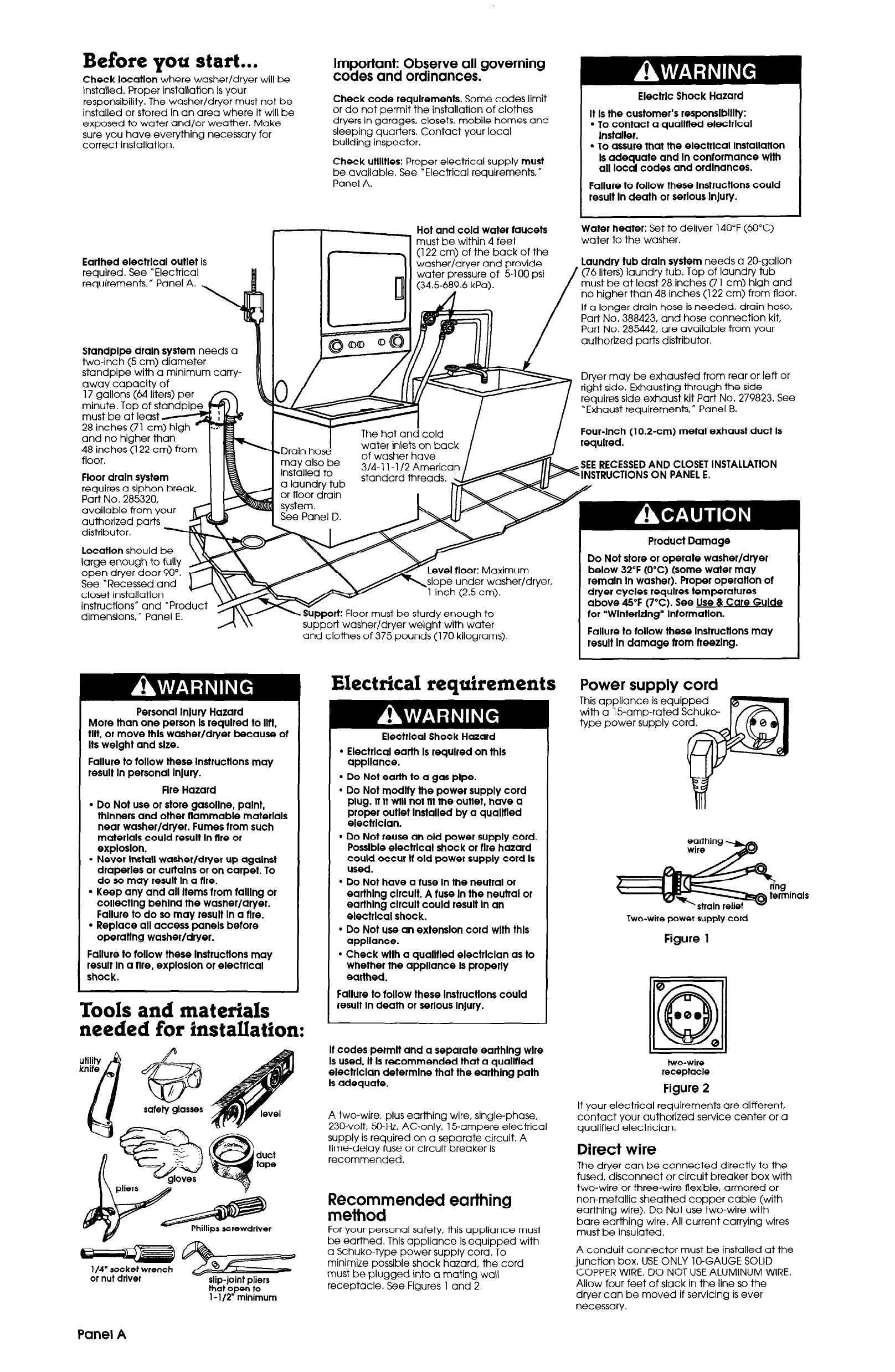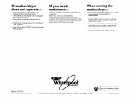
Before you start...
Check locatlon
where washer/dryer will be
Important: Observe all governing
codes and ordinances.
installed. Proper installation is your
responsibility. The washer/dryer must not be
installed or stored in an area where it will be
exposed to water and/or weather. Make
sure vou have evervthina necessarv for
correct installation. _ -
Check code requlrements.
Some codes limit
or do not permit the installation of clothes
dryers in garages, closets, mobile homes and
sleeping quarters. Contact your local
building inspector.
Check utllltles:
Proper electrical supply
must
be available. See *Electrical requirements,”
Panel A.
Earthed electrlcal outlet
is
required. See “Electrical
requirements,” Panel A.
Standplpe draln system
needs a
two-inch (5 cm) diameter
standpipe with a minimum carry-
away capacity of
must be at lea
and no higher than
48 inches (122 cm) from
floor.
Floor draln system
requires a siphon break,
Part No. 285320,
available from your
authorized parts
distributor.
Hot and cold water faucets
must be within 4 feet
(122 cm) of the back of the
washer/dryer and provide
water pressure of 5-100 psi
MI I
(34.56T.6 kPa).
/
T
The hot and cold /
I
Four-Inch (10.2-cm) metal exhaust duct Is
Electric Shock Hazard
It Is the customer’s responslblllty:
l
To contact a quallfled electrlcal
Installer.
l
To assure that the electrlcal lnstallatlon
Is adequate and In conformance wlth
all local codes and ordinances.
Failure to follow these lnstructlons could
result In death or serlous InJury.
Water heater:
Set to deliver 140°F (60°C)
water to the washer.
Laundry tub draln system
needs a 20-gallon
(76 liters) laundry tub. Top of laundry tub
must be at least 28 inches (71 cm) high and
no higher than 48 inches (122 cm) from floor.
If a longer drain hose is needed, drain hose.
Part No. 388423, and hose connection kit,
Part No. 285442, are available from your
authorized parts distributor.
Dryer may be exhausted from rear or left or
right side. Exhausting through the side
requires side exhaust kit Part No. 279823. See
“Exhaust requirements,” Panel B.
water inlets on back
of washer have
3/4-l l-1/2 Americ
standard threads.
SEE RECESSED AND CLOSET INSTALLATION
INSTRUCTIONS ON PANEL E.
Locatlon
should be
large enough to fully
open dryer door 90”.
See “Recessed and
closet installation
instructions” and “Pro
dimensions,” Panel E.
vel tloor:
Maximum
slope under washer/dryer,
ust be sturdy enough to
dryer weight with water
Do Not store or operate washer/dryer
below 32°F (0%) (some water may
remain In washer). Proper operatlon of
dryer cycles requires temperatures
above 45°F (7°C). See Use & Care Guide
tar “Wlnterlzlng” Intormatlon.
and clothes of 375 pounds (170 kilograms).
Product Damage
Failure to follow these lnstructlons may
result In damage from freezlng.
Personal InJury Hazard
More than one person Is required to Ilft,
tilt, or move thls washer/dryer because of
Its weight and size.
Failure to tallow these lnstructlons may
result In personal InJury.
Fire Hazard
l
Do Not use or store gasoline, palnt,
thinners and other flammable materials
near washer/dryer. Fumes from such
materials could result In flre or
exploslon.
l
Never Install washer/dryer up agalnst
draperies or curtains or on carpet. To
do so may result In a flre.
l
Keep any and all Items tram falling or
collecting behlnd the washer/dryer.
Failure to do so may result In a flre.
l
Replace all access panels betore
operating washer/dryer.
Failure to follow these lnstructlons may
result In a flre, exploslon or electrlcal
shock.
Tools and materials
needed for fnstaIIation:
l/4” rocket wrench
or
nut
driver
slio-ioint oliers
thbtbpeli to
1 - l/2” mlnimum
Electrical requirements
Electrlcal Shock Hazard
l
Electrlcal earth Is required on thls
appliance.
l
Do Not earth to a gas pipe.
l
Do Not modify the power supply cord
plug. It It will not Ilt the outlet, have a
proper outlet Installed by a qualltled
electrlclan.
l
Do Not reuse an old power supply cord.
Possible electrlcal shock or tire hazard
could occur It old power
supply
cord Is
used.
l
Do Not have a ruse In the neutral or
earthlng clrcult. A ruse In the neutral or
earthlng clrcult could result In an
electrlcal shock.
l
Do Not use an extension cord wlth thls
appliance.
l
Check wlth a quallfled electrlclan as to
whether the appliance Is properly
earthed.
Failure to follow these lnstructlons could
result In death or serious InJury.
It codes permit and a separate earthlng wire
Is used, It Is recommended that a quallfled
electrlclan determlne that the earthlng path
Is adequate.
A two-wire, plus earthing wire, single-phase,
230-volt, %-Hz, AC-only, 15-ampere electrical
supply is required on a separate circuit. A
time-delay fuse or circuit breaker is
recommended.
Recommended earthing
method
For your personal safety, this appliance must
be earthed. This appliance is equipped with
a Schuko-type power supply cord. To
minimize possible shock hazard, the cord
must be plugged into a mating wall
receptacle. See Figures 1 and 2.
Power supply cord
This appliance is equipped
with a 15-amp-rated Schuko-
type power supply co
Two-wire power supply cord
Figure 1
0
Iail
000
0
two-wire
receptacle
Figure 2
If your electrical requirements are different,
contact your authorized service center or a
qualified electrician.
Direct wire
The dryer can be connected directly to the
fused, disconnect or circuit breaker box with
two-wire or three-wire flexible, armored or
non-metallic sheathed copper cable (with
earthing wire). Do Not use two-wire with
bare earthing wire. All current carrying wires
must be
insulated.
A conduit connector must be installed at the
junction box. USE ONLY lo-GAUGE SOLID
COPPER WIRE. DO NOT USE ALUMINUM WIRE.
Allow four feet of slack in the line so the
dryer can be moved if servicing is ever
necessary.
Panel A









